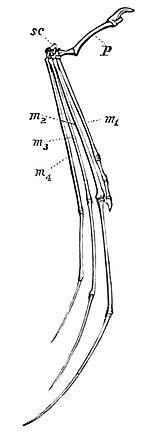and which, in the bat, by their contraction, strike the wings downward in flight.
Every one present must have observed, when carving a fowl, that there is a ridge or keel to the breastbone, and that a voluminous mass of muscle—the breast of the fowl—is situated on each side of such

Fig. 2.—s c, wrist-bones; p, bones of thumb; m1-4, bones of middle part of hands.
keel. Now, our bat has not got such a mass of muscle on each side of the keel of its breastbone as has the bird, and for a very good reason. In the bat, as in ourselves, the muscles which antagonize those just noticed (and which draw the arms away from the breast) are situated in the back; but, in the bird, both the muscles which strike the wings downward, and those which raise them upward, are together placed upon the breast, and hence its much deeper and more conspicuous keel. Still, though the muscular structure of the breast of a bat is not so perfectly arranged for flight as is that of a bird, it is an approximation to bird-structure, and one we can well understand from the similarity of action. But it may puzzle some of my hearers at first to think why the mole, of all creatures in the world, should have a breastbone at all like that of a bird. But a moment's reflection will make it obvious that the mole also requires most powerful breast-muscles, in order that it may dig its way through the soil with the wonderful speed with which it does dig through it. Similar causes produce similar effects, and thus it is that the mole, like the bat and the bird, comes to have a keeled breastbone.
